Unity of the Brethren
The Unity of the Brethren (Czech: Jednota bratrská; Latin: Unitas Fratrum), also known as the Evangelical Unity of the Bohemian and Moravian Brethren and the Czech Moravian Brethren Church, is a Hussite denomination founded in 1457, whose roots are in the pre-Reformation work of Petr Chelčický and Jan Hus (see Bohemian Reformation).[1][2]
| Unity of the Brethren | |
|---|---|
| Evangelical Unity of the Bohemian and Moravian Brethren Czech Moravian Brethren Church | |
| Classification | Protestant |
| Orientation | Hussite |
| Founder | Jan Hus and Petr Chelčický |
| Origin | 1457 Bohemia |
| Congregations | 28 |
| Number of followers | 3500 |
| Official website | unityofthebrethren.org |
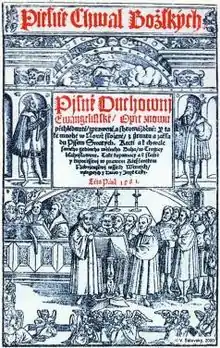
After 1620, the Unity of the Brethren Church was persecuted in Europe and as a result, communicants of the Unity of the Brethren Church worshipped in secret.[2] In the 1800s, Hussite immigrants to the United States organized in the state of Texas, where the Church is now based.[2]
The Unity of the Brethren Church shares the same lineage as the Hussite Church and Moravian Church.
History in Bohemia
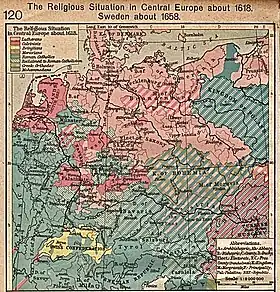
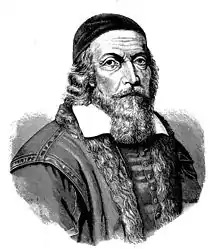
.jpg.webp)
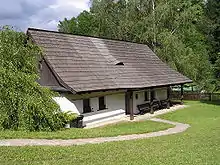
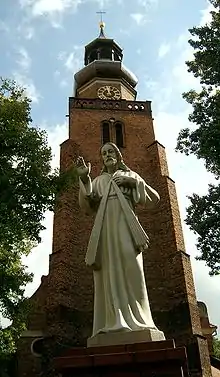
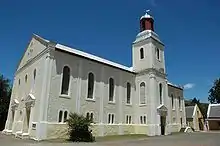
The reforms of Jan Hus, which included providing the Scriptures to the people in their own language and making both elements of communion available to the people, were popular with the Czech people, but met extreme opposition from church authorities. Hus was executed, but his preaching and writings were instrumental in the formation of the Hussite movement. The Hussite movement broke into several strands, one of which (the smallest) became known as the Unity of the Brethren.
The roots of this radical and pacifistic stream within the early Hussite movement go back to Petr Chelčický. Official formation is usually attributed to the year 1457 when the first ordinations took place in a small village called Kunvald near Žamberk and Litice, which was under the lordship of King George Podiebrad, in northeastern Bohemia. The original theological foundation for the future Unity of the Brethren was laid by Petr Chelčický and Brother Řehoř (Gregor), the latter often considered one of the main founders. Lukáš Pražský, whose theological ideas strongly shaped the movement after the passing of Chelčický and Řehoř, provided later leadership. Another important leader was Jan Augusta, who spent many years in horrible imprisonment. The "last bishop" of Unity of the Brethren, Comenius (Jan Amos Komenský) is known for his reforms in education. During the second half of the 16th century, members of the Unity of the Brethren translated the Bible from the original languages into the Czech. This translation is known as the Bible of Kralice (Bible kralická), which until recently was the most widely used Czech biblical translation, with an influence similar to the King James Version in the English-speaking world.
After 1620, due to a counter-reformation by the Roman Catholic Church, Bohemian Protestants were forced to choose between leaving the country or practicing their beliefs secretly. Descendants of members of the Unity of the Brethren who stayed in Bohemia and Moravia (keeping the Unity teachings alive by clandestine meetings), mostly from villages on the Moravian-Silesian border, made up the core of a regrouping a century later in Saxony under the influence of Count Nicholas Ludwig von Zinzendorf. They formed the church which is now known as the Moravian Church (in Canada and United States except Texas), Jednota bratrská (in the Czech Republic) and the Unity of the Brethren (in local languages mostly everywhere else, including Texas).
During the Thirty Years War, the Unity of the Brethren churches were severely persecuted, as they were targeted by local counter-reformation nobles. As a result, they were dispersed to other Slavic lands, various German states, and as far as the Low Countries, where Comenius attempted to direct a resurgence in manner similar to the secret Jews (Marranos) in Spanish Habsburg and other Roman Catholic lands.
Those who stayed in Bohemia and Moravia practiced their beliefs in secret and privately passed their beliefs from one generation to the next. Even after Emperor Joseph II proclaimed toleration in 1781, only Lutherans, Calvinists and Eastern Orthodox were allowed to openly practice their faith. Many of the Brethren united with the Lutherans and Calvinists around that time. After the end of World War I and the formation of Czechoslovakia in 1918, Czech Lutherans and Calvinists formed a united church – the Evangelical Church of Czech Brethren.
After the imperial edict of 1861, which granted legal rights to Reformed churches, Unity of the Brethren missionaries from Germany were able to restore the church to its original Czech homeland. The first congregations was founded in 1870 in Potštejn, and in Dube in 1872. Before the First World War, eight other churches had been planted. The Unity of the Brethren in the Czech Republic worked among the Czechs and the Germans, started orphanages in Čermná and Dubá, and conducted missionary work in South Africa.
The Czech-originated Unity of the Brethren should not be confused with the Unity of the Brethren Baptists, a Baptist organization in the Czech and Slovak Republics.
Restoration in Texas
From about the middle of the 19th century until the outbreak of the First World War, a number of Czech Protestants immigrated to the United States. In many parts of the U.S. they formed Czech congregations within the Presbyterian Church. Some who settled as farmers in the state of Texas decided to form their own denomination. Jindřich Juren (1850–1921) came to Texas in 1876, and from 1881 to 1888 was the only minister to these Brethren congregations. Representatives of these congregations met in 1903 and formed the Evangelical Unity of the Bohemian-Moravian Brethren in North America. The early churches reflected their origin and worshipped in the Czech language. By the 1940s, most of the churches reflected assimilation into the surrounding culture and worshipped in the English language. In 1959, the name Unity of the Brethren was adopted.
Doctrine
This body accepts the Apostles' Creed as a valid expression of their beliefs, and stresses the ancient motto, "In essentials, unity; in non-essentials, liberty; in all things, love." They believe the Bible is God's revelation to man, the sourcebook for all spiritual truth; that one God is revealed in three persons; that Christ is the only way of salvation; that salvation is by grace through faith; that the Holy Spirit dwells in believers; and that Jesus Christ will return to judge the world and reward the faithful believers. The Unity practices two sacraments—water baptism and holy communion. Christian parents present their infant children for baptism. All Christians are invited to communicate with them at the Lord's supper or communion. However, they do not regard full agreement on the elements, methods and modes of the sacraments as essential. They believe that love is the supreme evidence of Christian disciples.
Church emblem
The Unity of the Brethren church has adopted a church emblem having an open Bible, with a cross behind in the center, and a chalice in front to the left. According to the church, the "cross represents Christ as the resurrected and living Lord, the Bible is the sourcebook of all Christian truth, open for all to explore, while the chalice holds special significance for Brethren: not only is it a symbol of the Lord's Supper, but it is also a reminder of the pre-Reformation insistence of John Hus and the early Brethren upon receiving wine as well as bread in Holy Communion."
Status
Currently the church is made up of 28 congregations with an estimated membership of 3500, with all except one located in the state of Texas. The location of the majority of churches is roughly the area from West, Temple, to Austin to Houston. The synod meets every two years. The Unity of the Brethren maintains several ministry organizations, including the Board of Christian Education; Brethren Youth Fellowship; Brethren Bookstore, operated in Caldwell, Texas; Brethren Journal (founded 1902); Christian Sisters Unity; Friends of the Hus Encampment; Grants and Bequests Board; the Hus Institute for Lay Leadership (which meets with the various congregations); and the Mutual Aid Society. The Hus Encampment Facility is located near Caldwell, Texas. They have no seminary, but support the Moravian Theological Seminary in Bethlehem, Pennsylvania. Three missionary families are serving in Honduras and Mexico.
References
- "John Huss, Priest and Martyr". Biographical sketches of memorable Christians of the past. Society of Archbishop Justus. Retrieved May 5, 2016.
- Kurian, George Thomas; Day, Sarah Claudine (14 March 2017). The Essential Handbook of Denominations and Ministries. Baker Books. ISBN 978-1-4934-0640-1.
Further reading
- Encyclopedia of American Religions, J. Gordon Melton, editor
- Handbook of Denominations in the United States, by Frank S. Mead, Samuel S. Hill, and Craig D. Atwood
- Renewal of Church and Society in the Hussite Reformation, by Jacob K. Zeman
External links
- Unity of the Brethren (Texas) – official Web site
- The Birth, Life, and Death of the Bohemian Revival – a historical overview of the Unity's early days (1457–1620)
- Jindřich Juren – Unity of the Brethren minister, father of Texas church
- West Brethren Church, West, Texas
